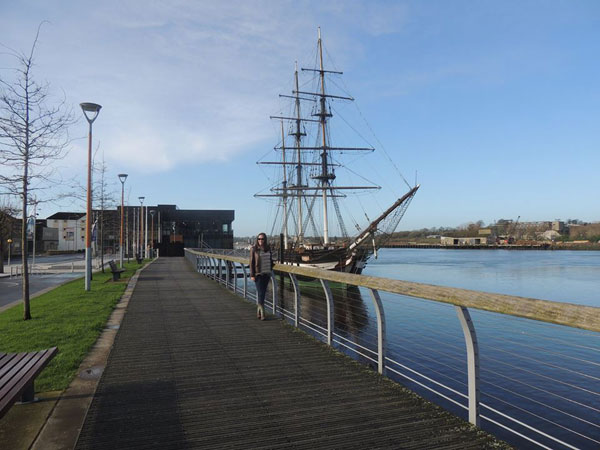New Ross is a beautiful town, full of interesting buildings, restaurants, pubs and cafes. Crossing the River its impossible not to be impressed by the Norman aspects of this lovely town, and The Dunbrody Famine Ship nestled into The Quay side, telling a story of a time we are all aware of, a time when many Irish were forced to flee this beautiful land in search of a better life, free of hunger.
Contact Information
The Dunbrody Famine Ship,
The Quay,
New Ross,
Co. Wexford.
Phone – 00353 (0)51 425239
Fax – 00353 (0)51 425249
Email – mailto:infor@dunbrody.com
Website – https://www.dunbrody.com
Opening Hours
The Dunbrody Famine Ship is open 7 days a week from 9.00AM – 6.00PM
Tour Information
Access to The Dunbrody Famine Ship is by Guided Tour only.
Your tour will be lead by experienced and knowledgeable tour guides who aim to make your trip to The Dunbrody Famine Ship an experience that you will never forget
The First tour is at 9.45
The Last tour leaves at 5pm.
Tour Pricing
10% discount when you book online at www.dunbrody.com
| Person | Price |
|---|---|
| Adult | €10 |
| Senior/Student | €8 |
| Child | €6 |
| Family (2 Adult + 1 Child, Under 12) | €22 |
| Family (2 Adult + 2 Children, Under 12) | €25 |
| Family (2 Adult + 3 Children, Under 12) | €30 |
The Dunbrody Famine Ship Experience and The Kennedy Homestead Joint Tickets.
| Person | Price |
|---|---|
| Family | €45 |
| Adult | €16 |
| Senior | €13.50 |
For group bookings please contact mauramurphy@dunbrody.com
Sinead’s thoughts on The Dunbrody Famine Ship.
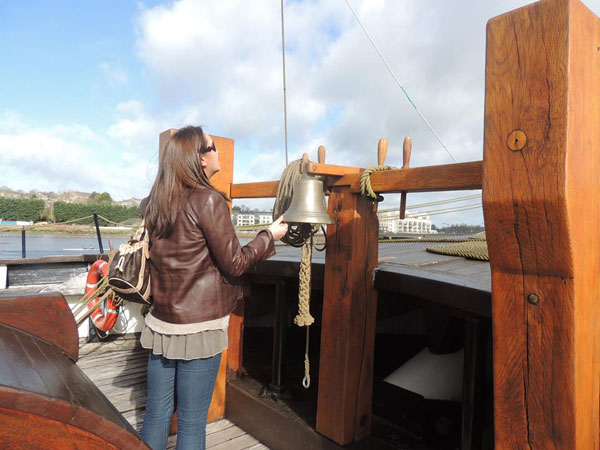
New Ross, Co Wexford is situated on the banks of beautiful and scenic River Barrow, which eventually meets the River Suir from Waterford, and the River Nore from Kilkenny, to form The River of the 3 Sisters. It is not hard to see why the Anglo Norman Lord William Marshall, founded the town of New Ross at this location, with its access to the southeastern trade routes and its clear views allowed for an easily defensible position.
The Famine stirs up many feelings and is an emotional subject, for me the sight of this majestic ship transports you back to a time where life was difficult and full of hardship, this ship would have transported people fleeing starvation and fighting to survive. The fear that they must have felt, but also the great sense of hope, that this ship must have represented.
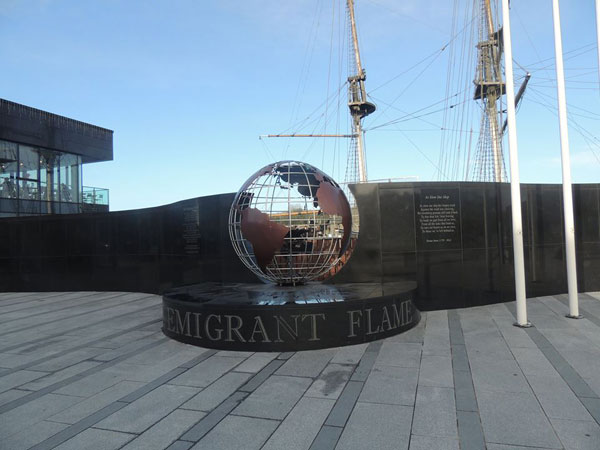
Having passed The Quays in New Ross on countless occasions, this was to be my first time boarding The Dunbrody, who’s masts seem to dominate the River, calling you to explore her history and the shared history between Ireland and the nations who’s shores offered our emigrants a chance at a better life and future. She sits silent and beautiful, a part of Irelands living history.
The Dunbrody has the proud privilege of reminding us to never forget where we all came from, no matter how far we have traveled, the call of home rings clear to all generations of emigrants and their descendants. The Dunbrody offers something extremely special to the descendants of all emigrants, it brings their family history to life, and for a moment allows all to remember, and become part of a time that influenced our futures. Allowing us to step into the lives of our ancestors and see the hardships they injured to give their descendants the lives we are grateful for today.
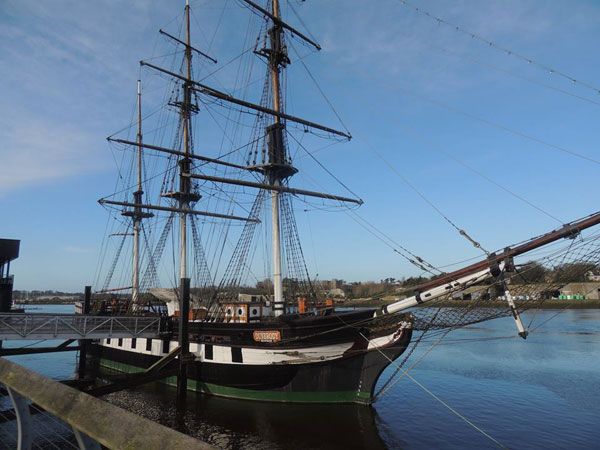
As I approached The Dunbrody’s magnificent Heritage Complex, I was drawn in by an emotional reminder of the past. The Emigrant Flame which burns bright as a constant reminder of those who left their homeland and made new homes throughout the world, bringing our culture everywhere they went and helping to build great nations.
This symbolic Emigrant Flame is a testament to the fact that all who left their homeland will never be forgotten and it is an emotional reminder of the vast numbers of emigrants that have left Ireland and continue to do so. This flames first light traveled 3,700 miles. A flame was taken from the Eternal Flame at the graveside of President John F Kennedy, in Arlington National Cemetery and carried to Ireland to Light the Emigrant Flame in New Ross, exactly 50 years after his visit, on June 22nd 2013. A quote engraved into the wall of this monument pulls at the heartstrings and the words are now etched into my mind.
“As slow our ship her foamy track
Against the wind was cleaving,
Her trembling pennant still look’d back
To the dear Isle ’twas leaving.
So loath we part from all we love,
From all the links that bind us;
So turn our hearts as on we rove,
To those we’ve left behind us.”
Thomas Moore(1779-1852)
As you enter the Heritage Complex, you will be greeted by warm and friendly staff, who are happy to help with all your queries. The Dunbrody Shop is stocked with wonderful and interesting items, you will find something for everyone here, and I particularly loved their books for children on Irish History. There are also selections of DVDs, CD’s and everything you can imagine with an Irish theme. The Dunbrody Heritage Complex has complete disability access, which includes the upper deck of the ship.
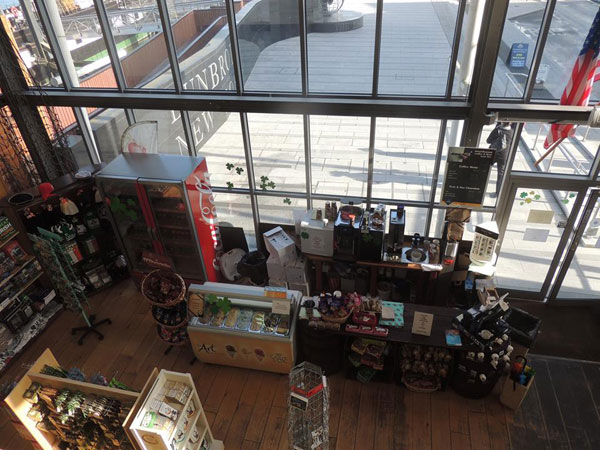
The Dunbrody Complex is home to the Hall of Fame Café and Restaurant. It is a marvel, with a beautiful menu that caters for all tastes with gluten free and vegetarian options, I was captivated by the display of wonderful desserts. The Hall of Fame Café has amazing views of the River Barrow; it is almost like you are sitting right on top of the river itself.
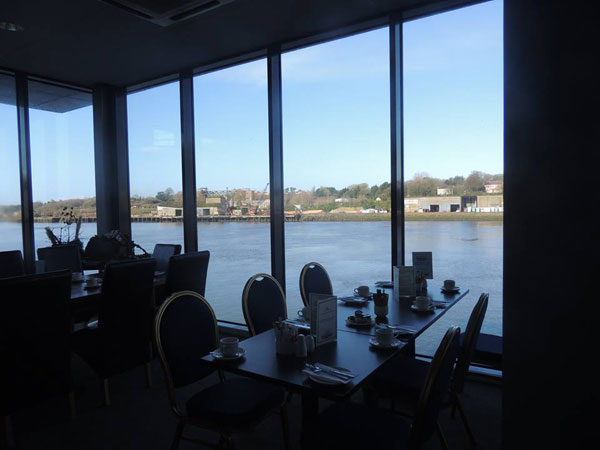
The Hall of Fame Café has many pictures of famous Irish emigrants and their descendents, such as The Kennedys. There are some very famous people remembered here that I did not know were of Irish decent, such as Walt Disney. They also have informative videos playing about many famous emigrants who made an impact on the world stage such as Waterford man Thomas Francis Meagher.
As you start your tour, you will be guided to an amazing information centre within the Heritage Complex. The walls are gilded with information on The Dunbrody and its history, as well as a clear explanation of The Great Famine and how Wexford and the surrounding areas were affected by this mass tragedy.
Your guide will be able to answer any questions you have. You will be guided into the world of New Ross and the surrounding areas during The Great Famine and how the people of this area coped, as well as a clear explanation of the potato blight. As you walk around this centre you will witness reconstructions and videos that will intrigue your imagination and perhaps bring a tear to your eye.
As you learn of the Dunbrody’s history you will learn that this ship was initially a cargo ship and was adapted to carry passengers during a time of mass exodus. Your guide will introduce you to the magnificent nautical architecture that is The Dunbrody, which is a perfect and exact reconstruction of the original Dunbrody, which would have taken the vast journey across the Atlantic.
As you board The Dunbrody you will be shocked and in awe of the craftsmanship that was undertaken to create her, there is even one part of this ships fixtures that was on the original Dunbrody! As I walked around I was amazed by the ships beauty and the wonderful interactive aspects that the guided tour offered, it was an outstanding experience.
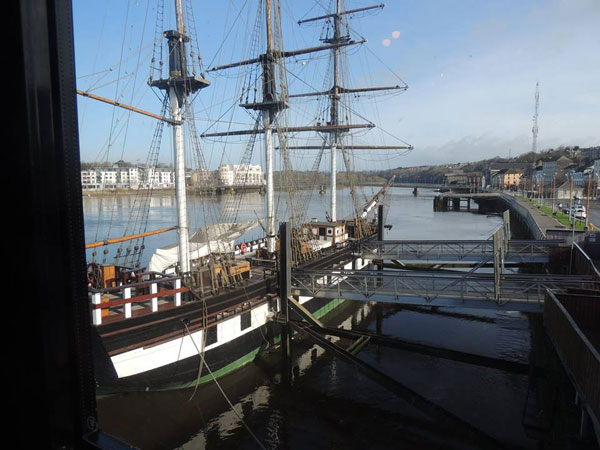
As I edged deeper into the lower deck of The Dunbrody, it is difficult not to feel a rush of emotion as you can witness first hand the conditions that the emigrants endured on the harrowing journey to a new life.
With an average of 200 people living in these cramped quarters with only short periods of relief on the upper deck, it would have been a horrendous experience, spending an average of 50 days within the bowels of this ship. Disease, such as typhoid and dysentery would have been a massive issue, as well as the lack of privacy and the constant sea sickness that would have stuck those stacked within the bunks.
The limited amount of food that steerage passengers would have received to eat is unimaginably awful and barely enough to keep them alive. If you died on board you would have been buried at sea to stem the spread of infection and disease.
Those who boarded The Dunbrody would have carried with them the only possessions they had in the world, and that was usually just what they carried in their arms. Many passages were paid for by Land Lords so as they could rid themselves of unwanted tenants. You will bare witness the story of human tragedy, as many died on board these ships, however the mortality rate on The Dunbrody was very low, the passengers on this ship were treated very well. It is important to remember where there is death there is also life, with births also taking place.
Although there was fear, of the unknown, the new life ahead and the fear they must have felt. They had no idea what they would do once they arrived at their destination. There was sorrow at leaving home but a hope that when you arrive on the shores of New York that a new world of opportunity is open to you and your family. One thing was certain, unlike today where we can get on a plane home, these emigrants would never seen Irish shores again, their family who stayed behind would become part of the stories that would be passed down though generations.
I wont tell you to much about the tour below decks because you need to experience it yourself to fully understand the magnitude of the voyage and there are several surprises to delight you along the way. I was given time to explore and take in all aspects of The Dunbrody, its rigging looming over head, the work hours of the crew must have been unbearable, climbing to massive heights to secure sails and ropes with no safety features to think of at this time.
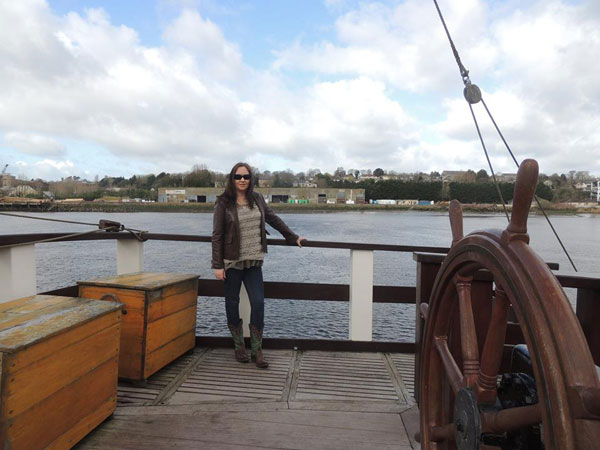
The crew would not have been paid for their work on board until the ship had safely docked back in New Ross and their living conditions were dire. First Class passengers would have had a much more pleasant voyage, many leaving because they could afford to and not because they had to.
I would like to thank our guide Jason for bringing The Dunbrody to life. The Dunbrody is like walking into history, it becomes real, and you can imagine what the voyage entailed. You can feel the ropes and timber of this ship, giving you the rare honor of being allowed to be in someway part of the past. For anyone who is visiting this beautiful area of Ireland, put The Dunbrody at the top of your list for things to do, it will be the best experience of your life.
As I departed the ship I was struck by the Emigrant Wall of Honor and took my time to read the names, and it is possible to have a name engraved on this beautiful and pointiest piece of Irish history. The Dunbrody insures that the emigrants that left our shores are never forgotten and will always be in our hearts. The Dunbrody is a wonderful and family friendly destination and has the ability to inspire people of any age or nationality. My next stop on my day’s adventures in New Ross was to The Family Home of JFK, known as The Kennedy Homestead.
A Brief History of The Great Famine.
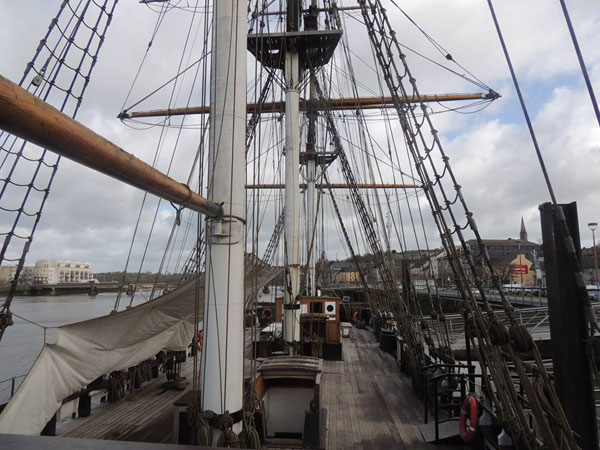
The Great Famine in Ireland is known by several names, The Great Famine, An Gorta Mor, The Great Hunger and The Potato Famine. It was a devastating event and the greatest tragedy in Irish history, an event that would change Ireland for all time. The worst years of the famine were from 1845-1849, however the effects of the Famine lasted for years. The social and physiological impact of The Great Famine have lasted lifetimes. It was a period of starvation, death, disease and mass emigration. Ireland’s population at the time of famine was approximately 9 million. The poorer people within Irish society were almost completely dependent on the potato crops; it was the main source of food for approximately 3 million people. When the potato blight struck it had devastating effects throughout the entire country.
At the time of The Great Famine, approximately 80% of the land in Ireland was in the hands of the British Gentry; most were granted their lands and titles during the 17th Century. Many of these Land Lord’s were absentee and the majority of their land was leased to wealthy farmers, who subsequently divided up these lands and subleased to poorer, tenant farmers resulting in large-scale subdivision of lands. Small farmers ended up with an average of 2 acres, consisting mainly of poor quality land. Hardly enough to feed families and earn living, potatoes were easily grown on these small plots of land and henceforth became the main food source.
Potato blight saw the main source of food for huge demographic disappear, combined with the Corn Laws which were implemented in 1846, resulting grain prices soaring to a such a high price people could not afford to buy it. The result was that many farmers in Ireland exported their grain and animals for sale throughout the British Empire. The grain in Ireland was exported because starving Irish poor, could not afford to buy it, it was a vicious circle. Public works were introduced paying workers barely enough to survive. Men, women and children were subjected to back breaking work in order to earn barely enough stop starvation.
As the years drew on the situation got worse. Ireland was ravaged by hunger, diseases such as black fever, yellow fever and typhoid. Harsh winters, lack of suitable clothing and warmth, all combined, resulted in what was a death sentence for the poor of Ireland. They had few choices. They either had to enter the workhouses, emigrate or die. The result of The Famine was over a million people died and approximately the same amount emigrated. Ireland lost 20% of its population. The Famine saw the Irish emigrate throughout the world and it was ships like The Dunbrody that facilitated their escape.
The Dunbrody.

The Dunbrody we see today is a perfectly crafted replica of the original vessel. The JFK Trust facilitated its construction in 1996. It is based on the original design of The Dunbrody that would have carried emigrants to a new life. The beautiful Dunbrody reconstruction took 5 years. The Dunbrody was launched on February 11th, 2001. Her maiden voyage was in 2005, where she joined The Tall Ships Festival in Waterford, she left her berth again in 2006 to make her voyage to Wales.
The Original Dunbrody
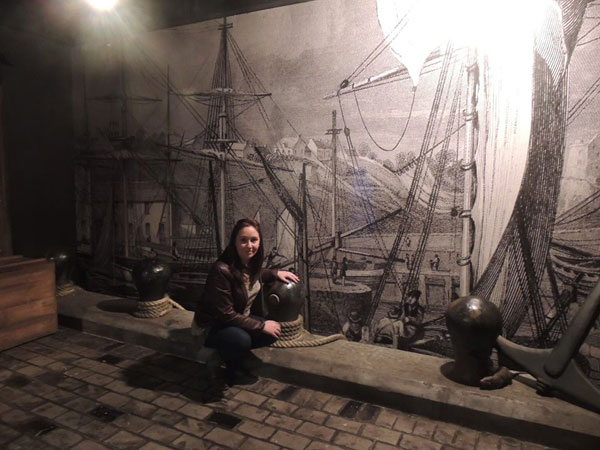
The Dunbrody was built in 1845 in Quebec, Canada. She and her sister ships were commissioned by a wealthy merchant family from New Ross, who operated a shipping company called ‘William Graves & Son’. She was originally designed to operate solely as a cargo vessel, transporting goods from The Americas back to Ireland. The transported items included timber from Canada, cotton from the Southern Sates of the United States and guano from Peru.
During The Great Famine people were desperate to leave and there were not enough passenger ships to transport them. The Graves Family seized on the opportunity to transport emigrants across The Atlantic. Their cargo ships such as The Dunbrody were fitted with bunks to house the emigrants on the long voyage.
Between the years 1845 – 1851 The Dunbrody transported thousands to a new life. On each voyage The Dunbrody carried between 150-300 passengers. Many of the passengers were tenant farmers who had worked on the vast estates of Lord Fitzwilliam, Co Wicklow who also held the title Viscount Vessi in Portlaoise.
The Dunbrody carried passengers to Quebec, Canada and to New York. The passengers, who were carried on The Dunbrody, were treated in an extremely humane manner by both Captain and crew. The Dunbrody had 2 Captains, Captain Baldwin and later John W Williams and their crew treated all passengers well and the mortality rate aboard The Dunbrody was extremely low.
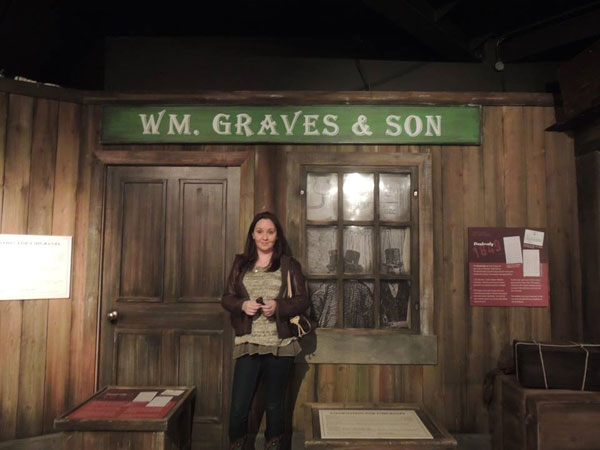
The Dunbrody served the Graves Family until 1869 when she was sold. In 1874 en route from Cardiff, Wales to Quebec, Canada, The Dunbrody ran aground while navigating the St Lawrence River. She was salvaged by a company who then brought her, but in 1876 she ran aground again off the coast of Labrador. She was abandoned and left to fade into history, until she was brought back to life in the reconstruction we see today, a vessel that will tell her story and the stories of her passengers for generations to come.

